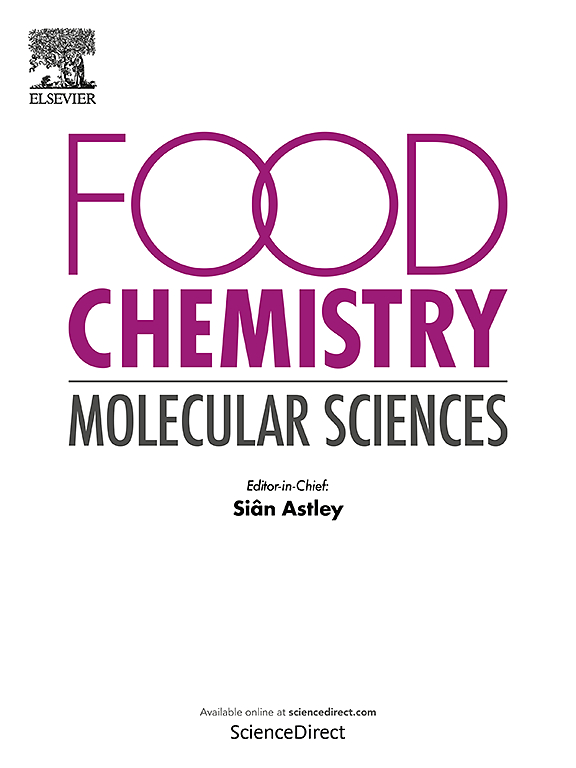饲粮中添加花椒籽对湖羊肌肉发育及挥发性物质的影响
IF 4.1
Q2 FOOD SCIENCE & TECHNOLOGY
引用次数: 0
摘要
花椒籽是一种营养丰富的副产品,具有作为湖羊可持续饲料的潜力。本研究旨在通过多组学分析,探讨饲粮中添加PAS对湖羊肌肉发育和挥发性化合物的影响。与CK组相比,饲粮中添加PAS增加了肌纤维直径和横截面积(P <;0.05)。转录组分析显示,ACTC1、SERPINA3、COX2、MYBPH、FMOD和KLHL34是参与肌肉生长发育的关键差异表达基因(DEGs),并通过氧化磷酸化、TCA循环、脂肪酸代谢和色氨酸代谢发挥作用。转录组学和挥发性代谢组学联合分析表明,LEP、ADCY1、TMEM54、COX2、PCK1和CPT1A可能通过参与脂质代谢,在十六烯、十二烷、2,6-十二烷-1-al、棕榈油酸、十二烷酸、乙酯等挥发性化合物的产生中发挥重要的调节作用。综上所述,PAS通过调节脂肪酸代谢相关基因,在湖羊生产、促进肌肉发育和影响肌肉风味方面具有广阔的应用前景本文章由计算机程序翻译,如有差异,请以英文原文为准。
Effects of dietary prickly ash seeds supplementation on muscle development and volatile compounds of Hu sheep
Prickly ash seeds (PAS), a nutrient-rich by-product, show potential as a sustainable feed for Hu sheep. The current study aims to explore the effects of dietary supplementation with PAS on muscle development and volatile compounds of Hu sheep through multi-omics analysis. The increased muscle fiber diameter and cross-sectional area was associated with dietary supplementation with PAS compared with the CK group (P < 0.05). Transcriptome analysis showed that ACTC1, SERPINA3, COX2, MYBPH, FMOD, and KLHL34 were key differentially expressed genes (DEGs) involved in muscle growth and development, and played a role through oxidative phosphorylation, TCA cycle, fatty acid metabolism, and tryptophan metabolism. The combined analysis of transcriptome and volatile metabolomics showed that LEP, ADCY1, TMEM54, COX2, PCK1, and CPT1A may play an important regulatory role in the production of volatile compounds such as cetene, dodecanal, 2,6-dodecadien-1-al, palmitoleic acid, dodecanoic acid, ethyl ester by participating in lipid metabolism. In summary, PAS demonstrates promise for Hu sheep production, enhancing muscle development and influencing muscle flavor by modulating fatty acid metabolism-related genes
求助全文
通过发布文献求助,成功后即可免费获取论文全文。
去求助
来源期刊

Food Chemistry Molecular Sciences
Agricultural and Biological Sciences-Food Science
CiteScore
6.00
自引率
0.00%
发文量
83
审稿时长
82 days
期刊介绍:
Food Chemistry: Molecular Sciences is one of three companion journals to the highly respected Food Chemistry.
Food Chemistry: Molecular Sciences is an open access journal publishing research advancing the theory and practice of molecular sciences of foods.
The types of articles considered are original research articles, analytical methods, comprehensive reviews and commentaries.
Topics include:
Molecular sciences relating to major and minor components of food (nutrients and bioactives) and their physiological, sensory, flavour, and microbiological aspects; data must be sufficient to demonstrate relevance to foods and as consumed by humans
Changes in molecular composition or structure in foods occurring or induced during growth, distribution and processing (industrial or domestic) or as a result of human metabolism
Quality, safety, authenticity and traceability of foods and packaging materials
Valorisation of food waste arising from processing and exploitation of by-products
Molecular sciences of additives, contaminants including agro-chemicals, together with their metabolism, food fate and benefit: risk to human health
Novel analytical and computational (bioinformatics) methods related to foods as consumed, nutrients and bioactives, sensory, metabolic fate, and origins of foods. Articles must be concerned with new or novel methods or novel uses and must be applied to real-world samples to demonstrate robustness. Those dealing with significant improvements to existing methods or foods and commodities from different regions, and re-use of existing data will be considered, provided authors can establish sufficient originality.
 求助内容:
求助内容: 应助结果提醒方式:
应助结果提醒方式:


